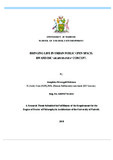| dc.description.abstract | Public open space plays a vital role is the social life of communities throughout the
world and forms an integral part of cities, so much that without it, it is said that
human settlements would be unimaginable. The production and use of urban public
open space (UPOS) varies from city to city, and from time to time due to the varied
social, economic, political and environmental considerations that influence urban
planning and development. This research is therefore concerned with bringing life
into UPOS, taking a case of the Rwandese akarubanda concept.
In Rwanda, historically, public space dominated the landscape and had a great
influence on the everyday living of Rwandans. Currently, however, the trend seems
to have faded away, so much so that the capital city of Rwanda, Kigali, does not
have sufficient UPOS, and the few existing spaces are empty and lacking life. In
Rwanda, land scarcity, coupled with high population density, pose a multifaceted
challenge to urban development. Land is continuously under so much pressure from
rapid urbanisation that the domain of UPOS seems to have been neglected by urban
planners and designers.
The selected cases for investigation helped to track the trajectory of public space in
Rwanda in order to arrive at the concept of a pragmatic UPOS; which enabled the
study to unpack ‘what works’ and how its application could bring back life into
Kigali’s Public Open Space. A traditional case study; of the Nyanza King’s palace
was used to find out ‘what was’, while a transformative case study; of the Biryogo
courtyard and node was used to demonstrate ‘what has changed’ and further, a
contemporary case study of the Rujugiro palace and compound was used to envision
‘what is’.
Therefore, as part of exploring UPOS and determining interventions needed, the
researcher used observation and mapping in order to determine the physical
dimensions such as accessibility and linkages. Field surveys and interviews with
xxi
residents and planners were used in order to gain insight on the social dimensions
such as the activities and user perceptions of UPOS. These empirical experiences,
combined with literature and document review, provided an analytical framework for
the assessment of selected case studies in Rwanda.
The findings of this study indicate that the current provision and use of public open
space have been less successful in offering a new meaning to the residents of Kigali.
There is a major weakness in the lack of the application of the akarubanda concept
to inform the current planning and management of urban space in the city.
The researcher concludes that bringing life back to UPOS enhances their liveability,
which is a crucial element in the structure of any city. Despite the challenges rapid
urbanisation poses, the concept of akarubanda remains relevant and useful for
people, time and space, because it allows the continuation of the transmission of
societal values as well as offering a balanced democratic space for building
relationships.
The knowledge that the study will contribute towards the relevance of indigenous
knowledge is indeed timely, not only for Rwanda and the East African region, but
also the continent of Africa and beyond, where there is an increasing interest for an
investigation into pressing urban issues, with public space being a key component. | en_US |



